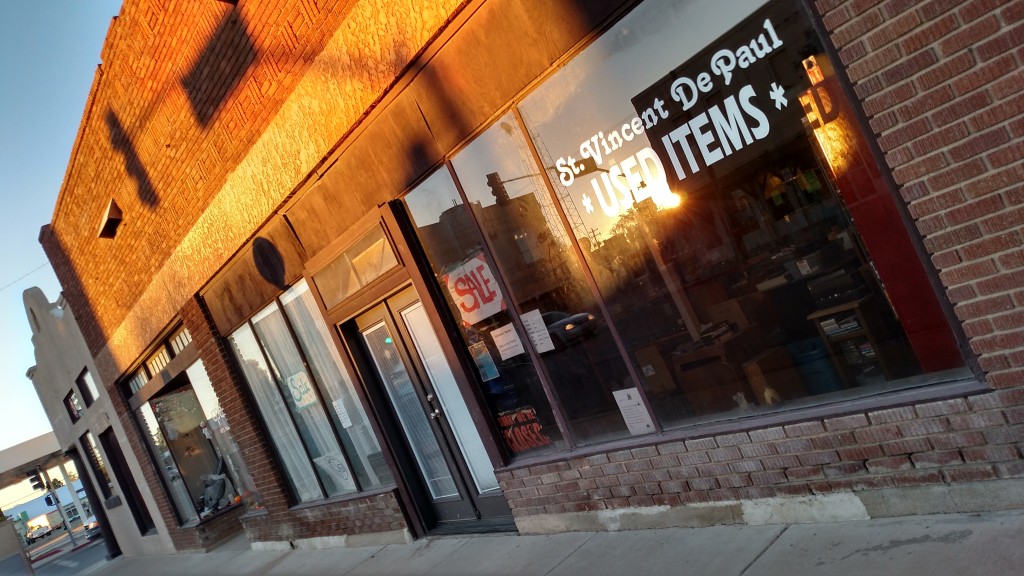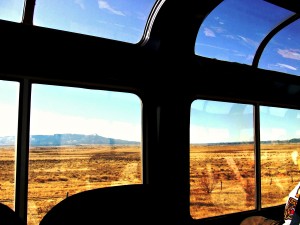
At closing time, we count the daily till. $22.50 in coins and small bills.
During our time volunteering in the store that day, five people made their way through the door. A young man, clearly mentally ill, rambling in a stream of consciousness. A single mom, in cowboy boots and a white t-shirt, prowling through the clothes. A woman with a long, gray braid down her back, carefully eyeing the mess that I’ve created. A talkative man walking with a cane as he searched the store for yarn; his companion standing near the front of the store trying to be patient.
Folks making ends meet.
In our little town, where many are struggling, that is a feat.
A ragged copy of the poem “Footprints” is thumbtacked askew to the wall under a detailed plastic crucifix. An indication of origin and intent.
We’ve thought about washing the front windows. “I’m not sure the glass is strong enough for a deep cleaning,” Mom fretted.
The landlord recently made some repairs after the vintage tin roof gave way, sprinkling insulation dust over a third of the store. The improvement added fresh paint to one wall, bringing the number of visible paint colors to seven.
I try not to wrinkle my nose in judgment when I walk through the front door. I try to remember the committed souls who volunteer their time to keep the doors open, and the humble funds that are poured back into community. But looking around kicks my “fixer upper” streak into high gear. “We should have a day of service,” I blurted out a few weeks ago, “and get rid of some of this stuff that will never sell.”
There is plenty that won’t sell. A constant stream of assorted junk and treasures arrives on the doorstep. To sort one from the other requires discerning eyes and a fair amount of heavy lifting. With a holder for floppy disks in hand, I ask, “Is this junk or will this be vintage at some point?” Hard to say.
The clothing racks are made from 2 x 4’s and silver pipe and wire. Functional and clunky, not beautiful. I spend an hour digging clothes out of a garbage bag and hanging things that pass my two second scan. Many have initials or a name marked in black Sharpie on the collar. Later, scanning the obituaries in the weekly newspaper, I recognize the letters. His earthly belongings were for sale before his body was laid to rest.
Everything in the store once had a home, perhaps even an important purpose or a place of honor. For a buck or two, they might have a home again. The confines of the thrift store are a temporary shelter, an in-between place. I pick up a decorative mirror with cracked edges from a crumpling box to set it on the display table. My image is reflected back at me. I, too, am in an in-between place.
The store is a place of creating small pockets of order within chaos. It is work that serves but doesn’t demand. It is what I can do right now.
I find a pair of black shoes in my size and slip $2 into the register.
I’ve always had a heart for the homeless.
 Mary lives in her childhood home at the base of a small mountain range in southern Arizona. She is daily torn between “inside work” (i.e. consulting and coaching maternity homes) and “outside work” (i.e. home improvements and helping her dad.) She is a founding member of You Are Here and a regular contributor.
Mary lives in her childhood home at the base of a small mountain range in southern Arizona. She is daily torn between “inside work” (i.e. consulting and coaching maternity homes) and “outside work” (i.e. home improvements and helping her dad.) She is a founding member of You Are Here and a regular contributor.

